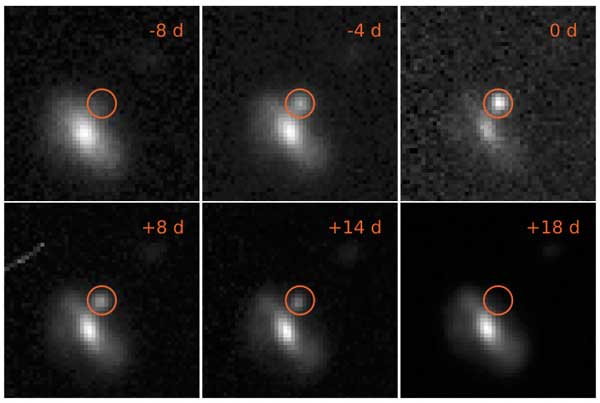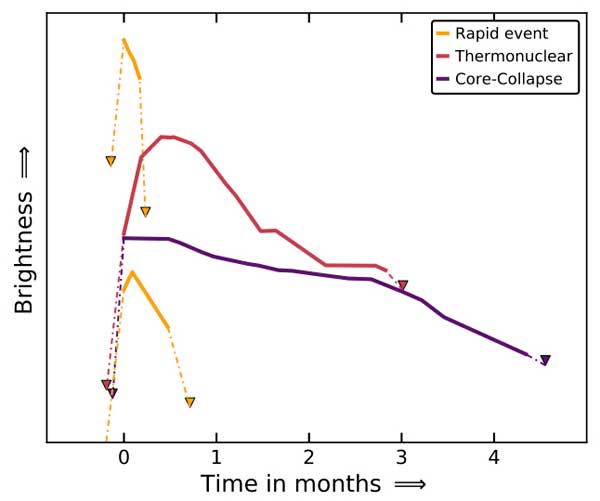Astronomers have discovered 72 fast and furious explosions, possibly supernovae blasts cloaked in cocoons of ejected gas.
Astronomers are uncovering the secrets of a rare kind of stellar explosion. Fast-evolving luminous transients (FELTs) are about as energetic as regular supernova explosions, but they rise and fade much faster. Because they’re such brief events, they generally escaped detection until the advent of large automated sky surveys. Over the past decade, a few dozen of these “fast supernovae” have been spotted, and many explanations have been put forward, from gamma-ray burst afterglows to failed thermonuclear stellar detonations.
The Supernova Program of the Dark Energy Survey (DES-SN) has now detected a whopping 72 of these remarkable explosions in remote galaxies — the greatest harvest ever, thanks to the power of the Dark Energy Camera on the 4-meter Blanco Telescope at the Cerro Tololo Inter-American Observatory in Chile. Team leader Miika Pursiainen (University of Southampton) presented the discoveries on April 3rd at the European Week of Astronomy and Space Science 2018 in Liverpool, UK. The fast supernovae lasted between a week and a month, while ordinary supernovae typically take months to disappear from view.

M. Pursiainen / University of Southampton and DES collaboration
From the survey data, Pursiainen and his colleagues conclude that the emission from a typical FELT comes from a hot, expanding shell of material – possibly a dense cocoon around an exploding star. The shell can measure anywhere between a few and 100 astronomical units (the average distance between Earth and the Sun) across, with a temperature between 10,000°C and 30,000°C. “There is no exact number on the event rate of these transients,” says Pursiainen, “but it’s likely on the order of a few percent of all supernovae.”
Recently, NASA’s Kepler space telescope precisely measured the brightness of one particular FELT (known as KSN 2015K) every 30 minutes over a three-week period. The accurate light curve enabled Armin Rest (Space Telescope Science Institute) and his team to firmly exclude a number of possible scenarios for this event. The only viable model, according to the astronomers, is one where a giant star sheds a huge amount of gas and dust just before it goes supernova. When the star explodes, the outer layers of the star slam into this thick cocoon, turning most of the kinetic energy into heat and light.

M. Pursiainen / University of Southampton / DES Collaboration
Because the light curves of the 72 events found by Pursiainen’s team have only a few data points, it’s unclear whether the same model applies to all of them, says Rest. “Most likely some of them are [similar to KSN 2015K], but I'm not sure about what fraction.”
Pursiainen agrees. The cocoon model is very attractive, he says, “but we have more work to do before we can be sure that this scenario explains all the observable features of our sample.” Future DES observations will reveal more FELTs, and studying larger numbers will certainly help to elucidate their true nature.
 1
1
Comments
Anthony Barreiro
April 5, 2018 at 7:14 pm
I'm beginning to think that the neat classification system of Type I and Type II supernovae, with their various subtypes, is largely a product of observation bias. Astrophysicists have come up with good models for the brightest and longest-lived stellar death throes, without realizing that a whole zoo full of massive stars has been blinking out of existence faster than we could notice.
You must be logged in to post a comment.
You must be logged in to post a comment.